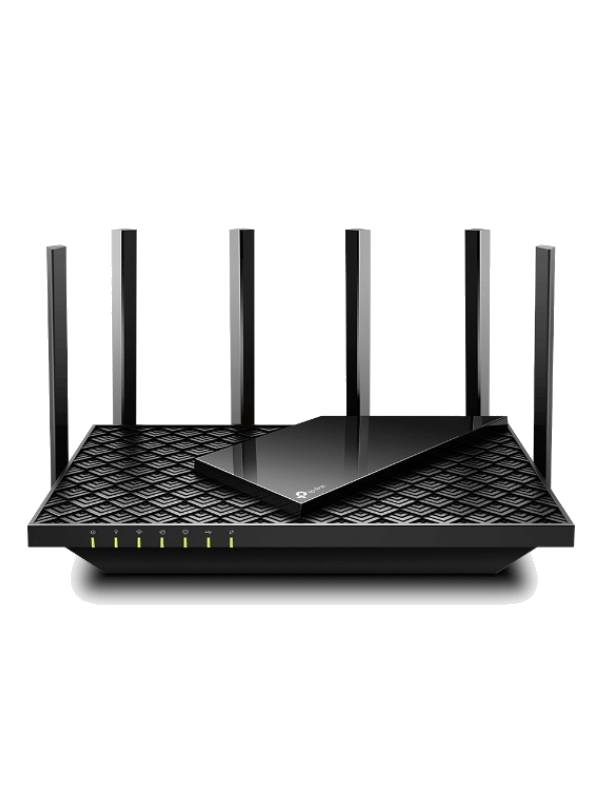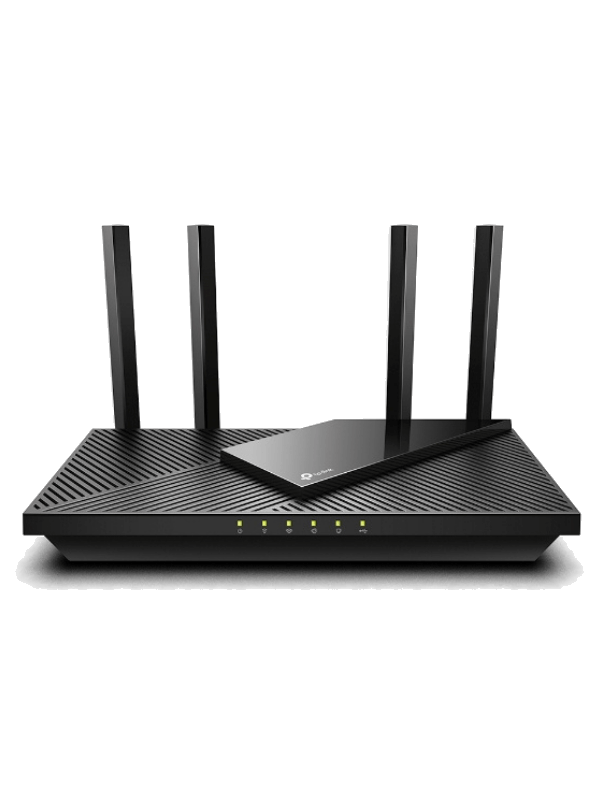Welcome along to our extensive review of the TP-Link Archer AX73 AX5400. We’re just going to refer to it as the AX73 from here on in!
To bring you the most accurate review we possibly could, we put the AX73 through its paces with a series of intense tests. These tests have mapped out how fast it is, how wide the range is and how good the features are.
Now that we’ve spent some time with the AX73, we’re ready to tell you all about it and give you a balanced opinion. The bottom line is that it’s very good, but there are a couple of areas we feel it could have performed better in considering the price.
Realistically, the AX73 will be a great router for a lot of people out there. But there may well be routers that are better suited to you. So read on, and you’ll be able to decide whether this could be your next router or not.
Specifications
| Brand | TP-Link |
| Model | Deco AX73 AX5400 |
| Max Tested Wi-Fi Speed | 827.85 Mbps |
| Approximate Range | 100-110ft |
| Wireless Standard | Wi-Fi 6 |
| Bands | 2.4 GHz, 5 GHz |
| WAN Port | 1x Gigabit |
| LAN Port | 4x Gigabit |
| USB Port | 1x USB 3.0 |
| QoS | Yes |
| Parental Controls | Yes |
| Guest Network | Yes |
| OFDMA | Yes |
| Dimensions | 10.7 × 5.8 × 1.9 in |
| Weight | 734g |
| Warranty | Limited lifetime |
TP-Link Archer AX73 Overview
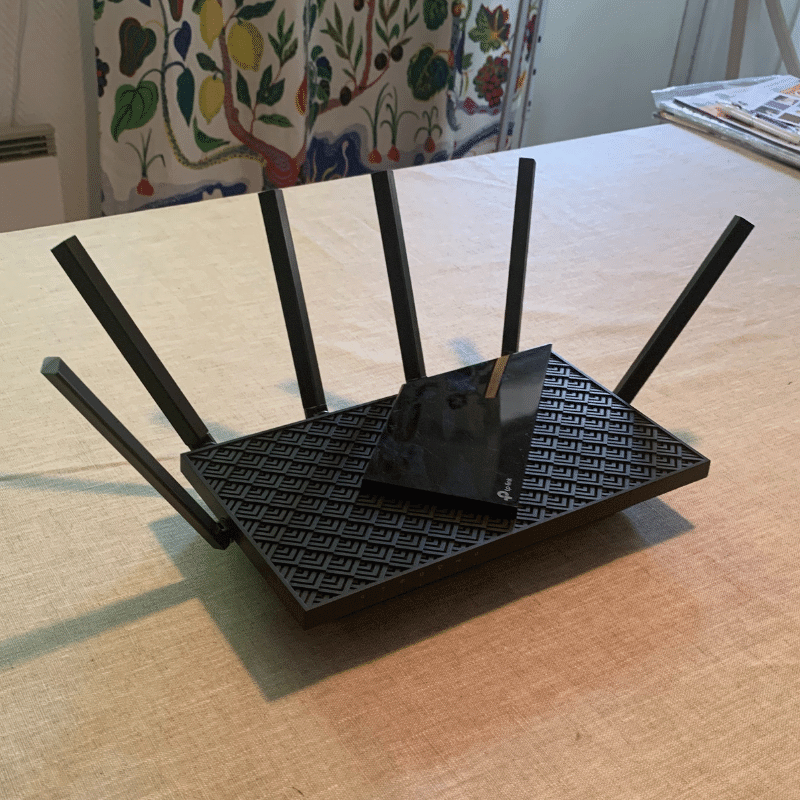
If you’re looking for a really quick router with a wide range, the TP-Link Archer AX73 could be well worth a look. It packs a real punch with its performance which justifies its price, which is a little on the high side.
On top of that, you’ll get a whole bunch of cool features. For example, the AX73 is Mesh ready thanks to TP-Link’s OneMesh technology. While the range itself is strong in itself (100-110ft according to our tests), you can extend it seamlessly. More on that later.
Our speed tests show that the AX73 will manage a pretty awesome top speed of 827.85 Mbps from 5ft away. This means it outperforms some more expensive routers. Not bad at all.
So is there any reason you wouldn’t buy an AX73? Is it the perfect router for you? These are the kinds of questions that need to be answered. But we’re sure you’ll be able to by the time you get to the end of this article.
By the way, before you buy your AX73 just remember that it is not a modem-router combo. So if you have cable internet, you’ll need to pick up a modem as well. Here are a few of the best ones for your consideration.
Performance: 4.4
The AX73 is in the upper bracket when it comes to router prices, and that’s because it considers itself to be a performance router. But does its speed justify that? The short answer is yes.
We came to that decision by putting it to the test ourselves. On the 5 GHz band from 5ft away, we managed a top speed of 827.85 Mbps on a Wi-Fi 6 device. That makes it quite a bit quicker than the more expensive ASUS RT-AX86U which managed 784.09 Mbps in the same test.
What does 827.85 Mbps look like? Well, when we put 800 Mbps to the test, we found that it would be more than enough for a workplace of 10-20 people, let alone a family home. You’ll just need to make sure you have the internet plan to match this kind of speed.
Interestingly, things aren’t quite so fast on the 2.4 GHz band. When we ran the same test from 5ft away on this band with a Wi-Fi 5 device instead of a Wi-Fi 6 one, the AX73 only managed a speed of 44.79 Mbps.
That’s a lot slower than the less expensive Archer AX50. This router managed a speed of 106.85 Mbps, quite a bit over double the AX73. Furthermore, the ASUS RT-AX86U outperforms the AX73. It managed 101.02 Mbps in the same test.
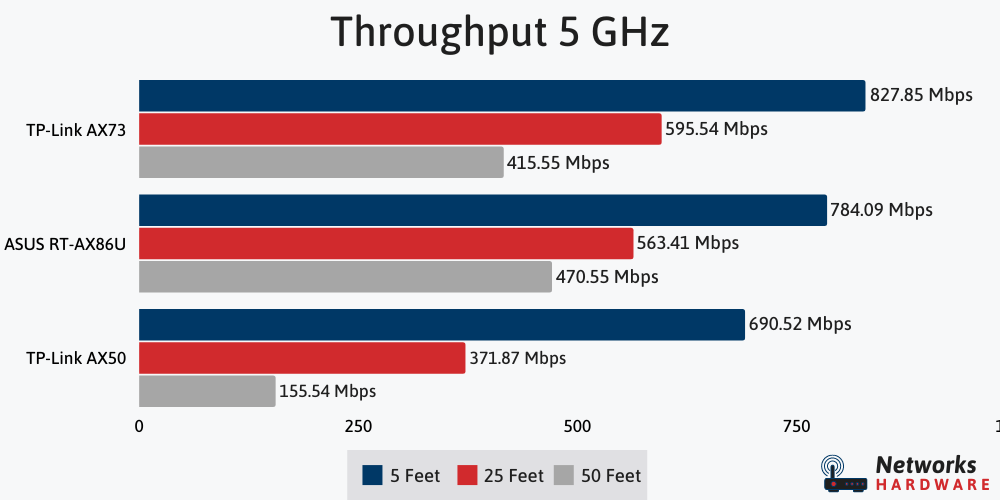
For this reason, we recommend the AX73 mainly to those who have Wi-Fi 6 devices that support a 5 GHz band and internet plans of up to 800 Mbps. These are generally newer devices, such as the iPhone 11 and later or the Apple Silicon Macs.
But there’s more to it than that. The 2.4 GHz band is the one with the wider range, so at first glance it may look like it doesn’t bode well for devices further away from the router. However, the AX73 managed to salvage things with its range.
We found that it could hold a signal as far as 100-110ft, which is really impressive. That’s enough range for a medium to large-sized home, and it’s about as good as it gets for router range without extension.
Plus, if you want to go further, you can boost the AX73’s range seamlessly thanks to its Mesh readiness. Let’s go into that in a bit more detail.
Features: 4.6
The AX73 is packed with great features that help to justify its price. Here’s a breakdown of a few of them.
OneMesh
Mesh seems to be the future, and increasingly more so the present. It allows users to extend the range of their home network without the need for additional network names. As a result, you’d be able to move around your home from satellite to satellite without ever dropping connection.
We recommend Mesh to anyone with a home of over 300 sq. ft in size. But with the AX73, it’ll be good to know that the option is there should you find that the 100-110ft range doesn’t quite cover every corner of your home (or you find yourself upgrading in size!)
Tether app
Controlling your AX73 home network couldn’t be easier thanks to the app that runs it all, Tether. You can use this to adjust any of the Wi-Fi settings including QoS and parental controls.
Plus, you can use it to set up your router in the first place. We’ll go into the setup process a little more shortly but believe us when we say, it’s easy! Furthermore, if you want to add Mesh satellites, you can easily do this through the Tether app as well.
QoS
One of those features that can be controlled through the Tether app is QoS, short for Quality of Service. In the case of the AX73, this allows you to select a handful of devices to be prioritized by the network, resulting in faster speeds and lower latency for a select period of time.
Considering the fact that it’s possible to connect up to 60 devices to this router, QoS can be really important if you need to override most of them to get something done. Whether it be a large file download or an intense gaming session, QoS can come in really handy.
We found the QoS feature on the AX73 to be pretty good. It enables you to really customize what you want to do with your preferences and as a result, have as much control over the network as possible.
HomeProtect
TP-Link’s HomeProtect feature is pretty awesome and you get it free for life when you buy an AX73. It consists of very strong parental controls and antivirus software, helping you to protect your network and the people using it.
If you’re not familiar with parental controls, allow us to explain. Parental controls allow you to control which devices on your network can access which types of content. So if you have young children in the home, you can make sure their devices are unable to access any malicious or inappropriate content.
HomeProtect antivirus is powered by Avira, one of the best in the game for router virus protection. They’re continually updating their HomeCare supply to be able to fight off all the latest threats. Plus, they can deliver comprehensive reports so that you can know what’s going on.
Connect up to 60 devices
This one kind of speaks for itself. The AX73 allows you to connect up to 60 devices at any one time. That’s more than we’ve seen on any of the dozens of routers we’ve been testing!
There are a few cool bits of Wi-Fi technology that support this: beamforming, MU-MIMO, and OFDMA. That might seem like jargon, and that’s because it is. But let’s take a quick look at what that all means.
MU-MIMO and OFDMA often go hand in hand because of the overall result of what they do, even though they do it in very different ways. They effectively help improve the performance on multiple connected devices plus boost the number of devices that can be connected.
The way MU-MIMO achieves this is by using the beams of the router to seek out the devices whereas OFDMA assigns subsets of carriers to the individual devices. That’s pretty neat stuff, and it’s relatively new technology that comes alongside the invention of Wi-Fi 6.
Then there’s beamforming. This one actually combines the router’s beams to assist it in seeking out devices on the network, boosting range and performance.
Limited lifetime warranty
One of our favorite things about TP-Link is the fact that a lot of their routers come with a warranty for life, the AX73 included. That means when you buy an AX73, you’ll be covered for any faults for as long as you own it.
We don’t know of any other router manufacturer that extends this kind of support. The closest joint-second is two years. So, TP-Link must really be confident in the reliability of their routers!
Design: 4.4
The TP-Link Archer AX73 has most of the ports you will need unless you have a ridiculously fast internet plan and not many devices to use it with.
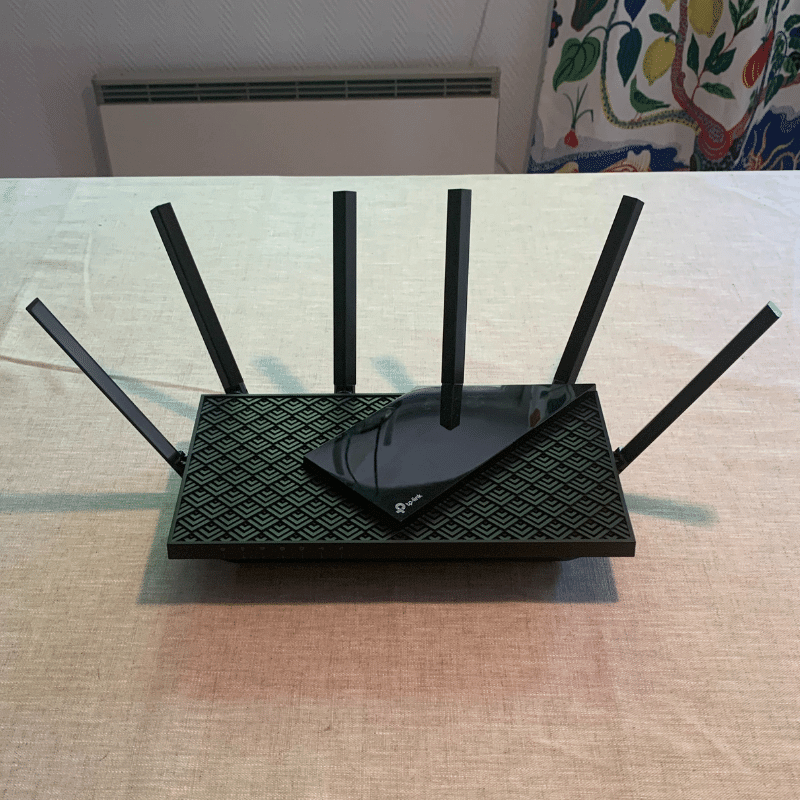
Off the bat, there are 4 regular Gigabit LAN ports. This means you can plug in as many as four devices for wired connections using Ethernet cables. This has the benefit of faster speeds that Wi-Fi is unable to reach (even with a Wi-Fi router as quick as this).
Disappointingly, however, there is no multi-gig port on the AX73. This is something we would’ve liked to have seen in a high-performance router such as this.
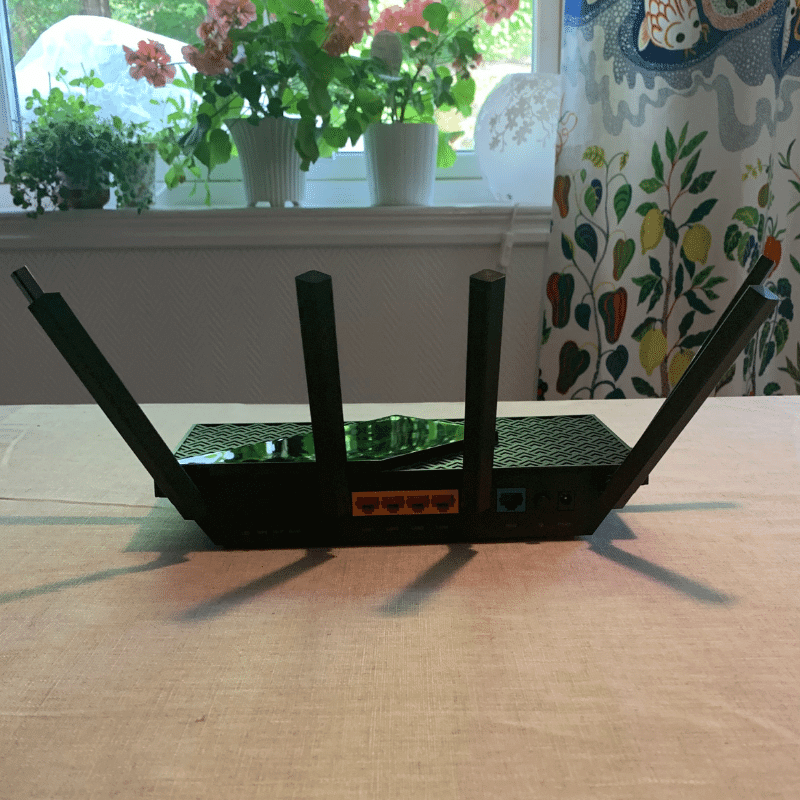
A multi-gig port is a LAN port that allows for connections faster than 1 Gigabit, usually 2.5 Gig. So if you have an internet plan of 2000 Mbps or so and you want to harness most of it with one device, you’re going to need to look for another router.
The AX73 does come with a USB port and it’s not just any USB port, it’s USB 3.0! That gives you a little extra power if you need to plug in external hardware (such as a printer) or charge a device.
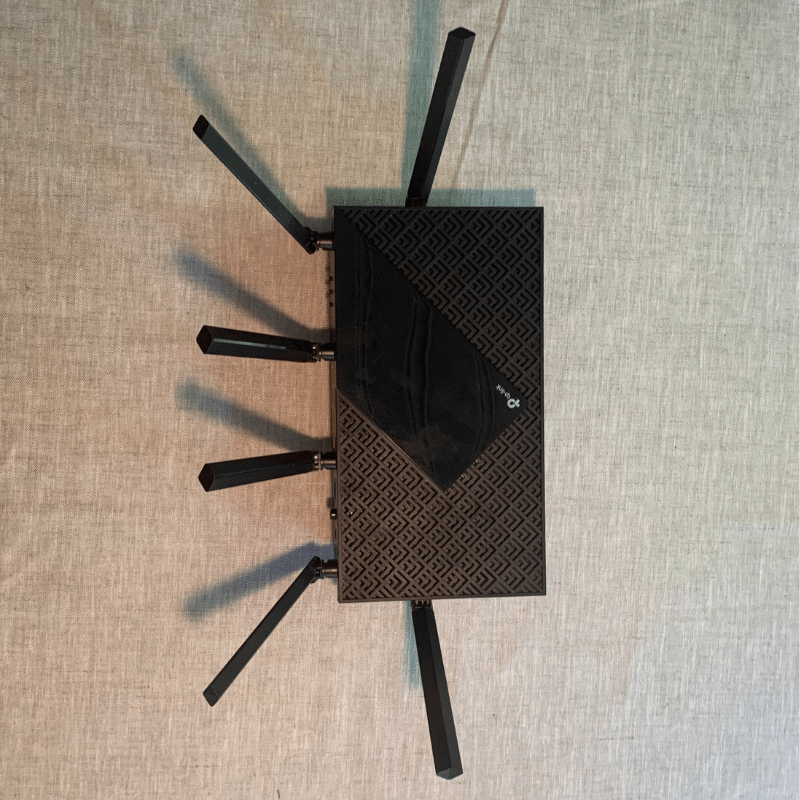
It’s also a very cool-looking router. You can tell this is one of TP-Link’s flagship devices as they have really tried to make it look impressive, which it does. Plus, it’s not too big and nice and light so you won’t have any issues with it getting in the way or being difficult to transport.
Setup: 4.8
As a result of the Tether app, setting up your AX73 will be a walk in the park. We found the whole process to only take a couple of minutes and because it guides you through everything, even the least tech-savvy of readers should be able to work it out quickly.
Just plug your router into the mains and into the internet wall outlet using the cables that come in the router box and turn it on. While it’s booting up, download the Tether app and run it with your Bluetooth switched on.
Tether will automatically detect your router and guide you through how to set it up, which is effectively just the touch of a button.
If you don’t have a smartphone, don’t worry. You can get around this by entering “192.168.1.1” into your browser.
Value: 4.5
The AX73 is a little on the high side, price-wise. But that’s because it’s a high-performance router. So when we compare its performance and features to some other similarly-priced routers, we can tell that it actually offers some of the best value for money in its class.
Take a look at the ASUS RT-AX86U, for example. This router is more expensive than the AX73 yet the AX73 outperforms it when looking at pure top speed. Our download speed test clocked a top speed of 827.85 Mbps for the AX73 compared to the 784.09 Mbps of the ASUS offering.
In terms of features, the ASUS and TP-Link models are pretty much neck and neck. Plus, you get more warranty with the AX73. The only thing the ASUS model really wins on is its performance with Wi-Fi 5 devices.
That’s just one example of how good the value for the AX73 is. It’d get even better marks if its 2.4 GHz band was a bit quicker!
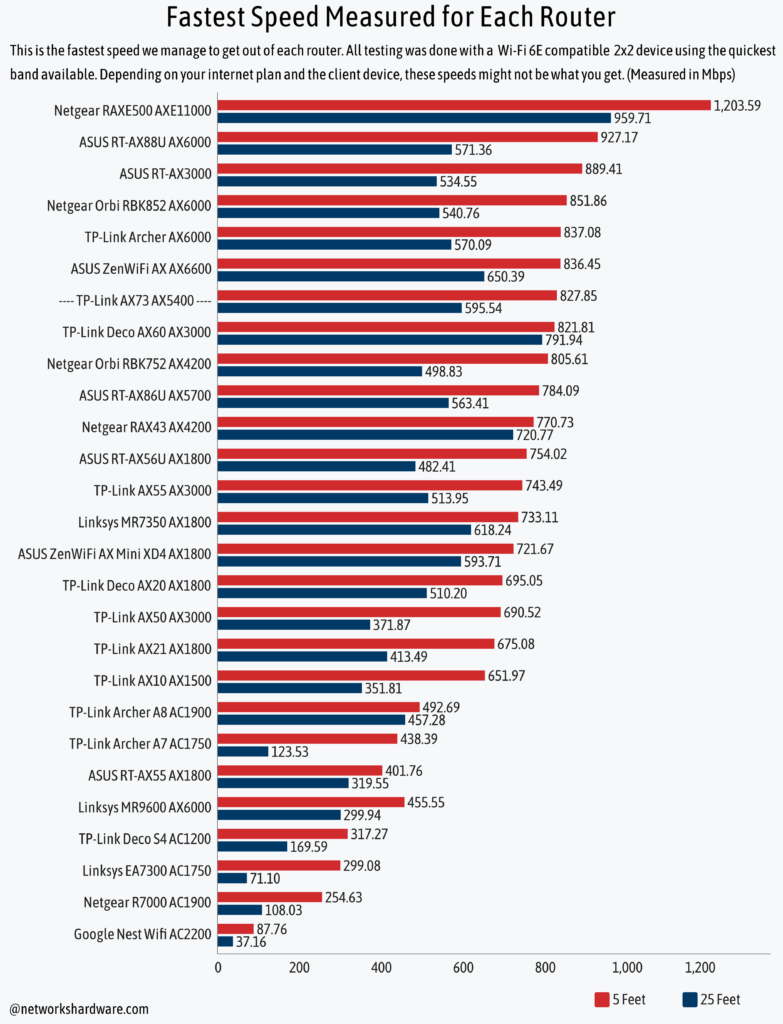
Opinions From Across the Web
Here’s the part where we take a look at what some of the other pundits have been saying about the AX73. This helps us deliver the most balanced overall opinion to our readers as possible!
Across the web, the AX73 has very strong reviews all around. A lot of critics have been heaping praise on it for its high performance, especially when compared to some even more expensive routers.
Reviewers are loving the fact that it comes loaded with excellent parental controls and QoS plus premium security. On top of that, everyone’s excited about how easy it is to add Mesh satellites to your network thanks to the inclusion of OneMesh technology.
In fact, the only real criticisms we have read about the AX73 are the fact that the 2.4 GHz band performance is a little slow and there is no multi-gig port. We’ve covered these two points in our review and we agree. But the bottom line is that the AX73 is a very good router indeed.
Other Router Options to Consider
We’ve been heaping the praise on the AX73 but it is a high-performance router and not a lot of people will need that. If you have an internet plan of 800 Mbps and/or a small-medium-sized home, you might want to save some money by going for a cheaper option.
Here’s a look at some of the alternatives you should check out.

